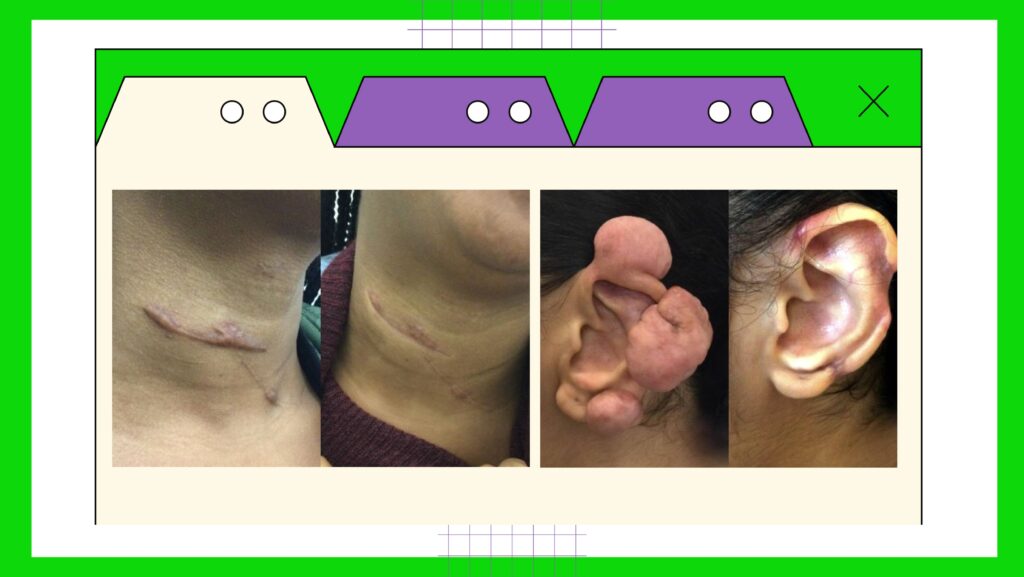Keloids are a result of trauma to the skin, for example from a cut, burn or piercing, and affect around 10% of people. The scar from the trauma keeps growing, due to an excessive amount of collagen, until it becomes bigger than the original wound and forms a benign tumour.
Though men and women are equally at risk of keloids, people of African, Asian, and Hispanic descent are 4.5% to 16% more likely to develop them. Dr Salinda Johnson, medical director and aesthetic dermatologist at The London Cosmetic Clinic, says this is because “darker skin has lots more cells that produce collagen compared to white skin”.
Nsuku Mab from South Africa noticed a keloid forming on her left ear lobe in February 2020, but it took a whole year to realise it was getting bigger. “It had grown by a centimetre by February 2021, and by the end of the month it grew even bigger,” she says. “It didn’t bother me until it grew bigger and became itchy.” At its biggest, Nsuku’s keloid was 4cm. “That’s when I knew I had to get rid of it,” she says. “It was also starting to affect my self-confidence. It was embarrassing.”
Keloids most commonly occur on the chest, shoulder, jawline and ear, with each area presenting different challenges to treatment and aftercare. “Ear keloids are really interesting because they tend to look like a grape, like a ball, whereas on other areas of the body they appear as a patch,” says Dr Johnson. “The ball is very thick, so if it gets infected, you’re going to need a lot more injections to tackle it. However, ear keloids have a much lower chance of growing back. The worst place to have a keloid, and the highest chance it will grow back, is the chest.”
“My ear would be in pain for a day or two after getting the injection. It was excruciating. But I don’t feel pain anymore”
If you find yourself in the 10%, perhaps after seeing a dodgy piercer or getting an unfortunate bug bite, there are multiple surgical removal options you can consider. For those that are squeamish around needles, Dr Johnson recommends having it shaved off, as precision electrosurgery eliminates the need for stitches by controlling the bleeding. For the less faint of heart, the simple “cut off and stitch up” method may be more appealing. Lastly, patients can also have their keloids frozen off with liquid nitrogen – the safest and most effective treatment.
Nsuku, who has “keloid survivor” sitting proudly in her TikTok bio, opted for the second option in February 2022. Describing the removal process, she says, “they numbed the keloid in the front and back, cut it out and burnt the open wound, scarped the dead skin and stitched it up.” She was then faced with a series of bi-weekly injections for six months to help prevent the keloid from returning. “My ear would be in pain for a day or two after getting the injection. It was excruciating. But I don’t feel pain anymore, it’s soft. It feels like I never had the keloid,” she says.
However, the process may continue for Nsuku, as it does for most people with keloids. The journey of removal is lengthy. “The minute you remove the keloid, there’s a very high chance it will grow back,” says Dr Johnson, also known as Dr Keloid. This might be the understatement of the century. According to the American Academy of Dermatology, nearly 100% of keloids return after they have been surgically removed, sometimes even bigger and more painful than before. But there are ways of preventing this.
Taking after care seriously is important with any medical procedure, but especially when it involves dealing with tumours. Though they are benign, you are still required to have a course of either injection chemotherapy or radiation after the fact. “But even if you do that, there’s still a chance of it coming back,” says Dr Johnson, who recommends a course of five chemotherapy injections – the first one after a month, and then every three to four weeks after that.
The road to recovery after keloid removal surgery is a long and uncertain one. Many people spend thousands having the tumours removed, only for them to come back more aggressive than ever, so it’s important to know this risk before committing to a painful and expensive surgery. However, as Nsuku can attest, it has the power to restore confidence in yourself and love of your skin.
Read the rest of our SKiN Stories series here: https://mccs-journalism.gold.ac.uk/wp/skin/author/rrobi001/

